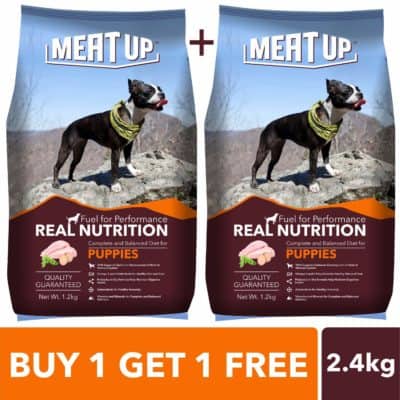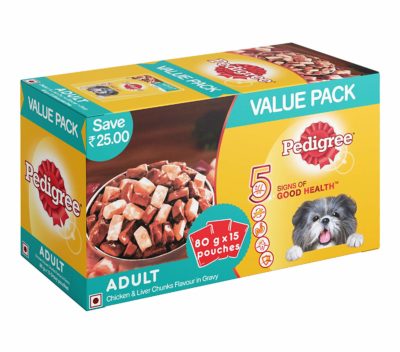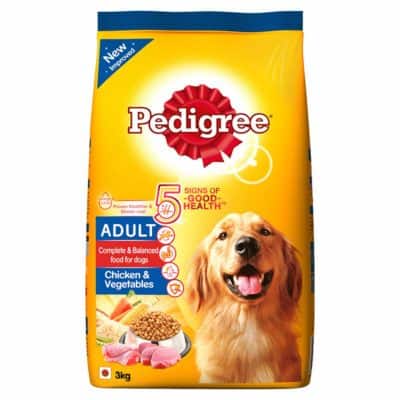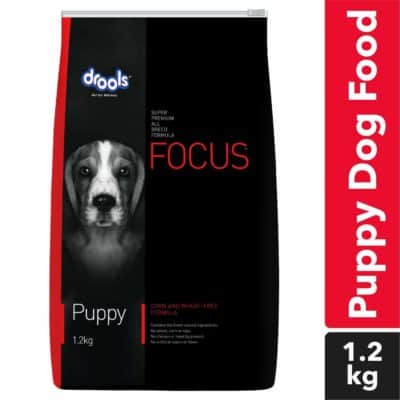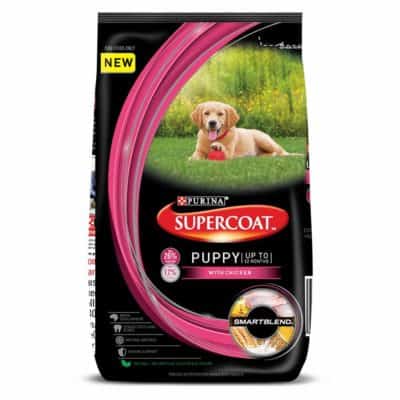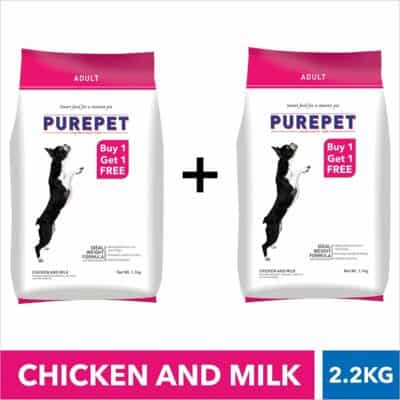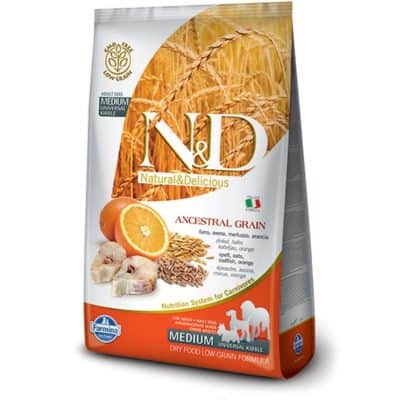Best Dog Foods
Dog’s are truly a man’s best friend. They are an important part of our lives, and they deserve to be given the best food so that they are strong and healthy. When we come home to our furry friend waiting eagerly at the door, we are full of happiness and joy. Watching their tails wag as you feed them is a great feeling.
Each dog is different and will like a different type of dog food. It is important to try out different foods so that you can get an idea as to what your dog likes. They should not be given the food humans eat because they are different from us and need a specific diet type.
In this review, you will read about why you need to pay extra attention to what your dog eats, reasons for dog obesity, signs, and symptoms of allergies in dogs, types of dog foods, buyers-guide to help you make the right decision and FAQs.
9 Best Dog Foods in India
| Product (Best Brands) | Best Price |
|---|---|
Ultra-rich Preparation For all Breeds | |
Great for Growth, Immunity | |
Top-notch Nutrition For Adults | |
A Well-rounded Nutritional Formula | |
Optimized Formula For Bone And Muscle | |
Great for Overall Immunity | |
Great for Puppy Growth | |
Great Adult Maintenance Formula | |
Animal And Plant-based Ingredients |
Dog Food: Why You Need to Pay Extra Attention to What Your Dog Eats
This might look like a straight-forward question with an obvious answer, but let’s face it; there is more to dog food. Like humans, most of a dog’s health comes down to what it consumes daily.
Human food isn’t primarily made for a dog’s digestive system
No matter how eager your pups are at jumping at some leftovers from the table, making it a habit of feeding them, large quantities is a very inadvisable practice from an expert’s point of view.
The main reason why dogs should be exempted from our food is that their bodies are simply not programmed to digest food in the same way we do. A dog’s digestive system can’t process some foodstuff as effectively as ours.
Some of them include:
- Saturated fats.
- Additives.
- Preservatives.
Dog obesity
Dog obesity (excessive weight) has been a massive problem in most countries though it doesn’t get the same attention as human obesity.
According to veterinarians, within the Association of Pet Obesity Prevention, over 52.7 percent of dogs are either obese or overweight, of which 17.6 percent are confirmed obesity cases.
Main causes include:
- Consumption of human/table foods.
- General lack of control when it comes to the use of commercial dog foods.
- Lack of physical exercise.
If this condition isn’t checked, it can significantly impinge on the dog’s quality of life by leading to other more severe conditions. The most common associated conditions include:
- High blood pressure.
- Heart disease.
- Arthritis (joint disease).
- Liver disease.
- Kidney disease.
Worldwide statistics related to obesity are quite alarming. Fortunately, something can be done to prevent this, and it all begins with fixing the dog’s nutrition.
It’s mostly about making a single right decision at a time in pursuit of the best possible diet for the dog.
The ultimate goal should be to annihilate human food from the diet and replace it with carefully prepared food to meet the essential needs of the dog’s body.
Signs and Symptoms of Allergies in Dogs
To ascertain whether your dog needs hypoallergenic foods or not, you need to be aware of several common signs and symptoms. Some reactions can be observed on the skin. Common examples include excessive redness, itchiness, scabbing, and scales.
Other signs include red eyes, sneezing, swollen paws, loss of hair, diarrhoea, vomiting, dizziness, and general gastrointestinal (stomach) distress. Additionally, they also tend to become lazy and immobile.
Most of the time, owners are unsure about which ingredients are causing the allergies. Your vet will take the dog through a detailed assessment to identify the underlying cause.
A common technique is to use what’s known as an elimination diet that helps in ruling out which kinds of substances are involved or not.
Once the ingredient is identified, it’s usually a simple and straightforward process. On the other hand, if it’s yet to be identified, the vet can take the dog through a hypoallergenic diet, which might further identify the root cause.
Dogs on restrictive foods require identical amounts of nutrients and other essential substances as other dogs. All that is needed are creative ways of making sure they get what they need without triggering any allergies.
Types of Dog Foods
Manufacturers seem to have a great understanding that their customers are vastly diverse based on several factors. Just as it is with human food, there is a diversity of dog food based on consistency, texture, and nutritional value.
There are seven critical types of dog food, and these are discussed below.
Wet Food
Wet dog food, also known by the term canned dog food, typically comes in containers designed to maintain moisture.
They commonly come in cans (thus the name “canned foods”) or individual pouches. As expected, they are quite saturated and hold excess moisture, though not entirely liquid.
Wet foods are excellent for hydration as they have an abundant supply of water. It is also considered an excellent choice for older pets as it is generally more appealing in terms of taste and high energy nutrition value.
Like most foods, wet dog foods come with high protein composition and fewer carbohydrates. As indicated above, dog food also comes in various flavours, including chicken and turkey gravy.
The term gravy generally refers to the sauce typically made of juice extracts from different types of meat and some grains such as wheat.
It commonly comes with canned foods and has long proven itself as a dog favourite due to the superior taste and smell it adds to the meal.
However, there are a few disadvantages of wet dog food that every owner needs to be aware of. The food’s high value and other packaging needs make it more expensive and tend to have a shorter shelf life once it’s unsealed.
In cases where you get it opened and your dog isn’t inclined to consume it, you may need to refrigerate it while keeping the right conditions in mind.
You need to remember that though these foods may prove expensive, they tend to come with impressive nutritional value for both older dogs and puppies. The processing ensures that most of the vitamins and minerals are preserved.
Dry Food
Dry food is also commonly known as Kibble, and it is typically packed in bags and come in bulkier packages compared to wet dog food.
They are generally a dough product, which is subjected under higher pressure and forced out through a variety of holes for proper sizing.
The dough used in the dog food is dried and treated with a special solution containing the specific nutrients that the manufacturers want it to possess.
Though not exactly as appealing as wet food when it comes to taste, it still comes out delicious for most pets. Due to the low water composition associated with the food, you must ensure a water bowl nearby to keep the pet hydrated.
As you would expect, there has always been a debate relating to the superior type. The best example for your dog can be detailed as other factors may also heavily influence what you choose for your dog.
However, for reference, combining the two types of foods is highly recommended as it makes the diet much more balanced.
Dry food comes out as a natural favourite for pet owners due to its simplicity and convenience when it comes to preparation and the long lifespan it possesses once it is opened.
The idea of opening your kibble and a water bowl and simply forget it seems like an appealing prospect for most busy owners.
Kibble is also considered a great choice when it comes to your pet’s gum and teeth health. Its chewiness and high consistency assist with removing tartar and plaque formations from the teeth.
This is one of the reasons why it is considered a great compliment to a comprehensive wet meal.
Raw Diet
Using raw food is based on the observation that dogs prefer raw food, which they ate before becoming domesticated animals.
It is an approach that tries to keep the food as natural as possible, thus keeping it appropriate for the dog’s digestive system’s natural abilities.
Common ingredients include meat, vegetables, fruits and a range of other organic components. This is why it’s sometimes known as evolutionary or Paleo diet.
The approach was introduced in the early ’90s by an Australian veterinarian named Ian Billinghurst, who was concerned with inappropriately high amounts of grains observed in processed foods.
The approach is also based on the premise that dogs do not need anything apart from meat and supplemented vitamins and minerals as with all canines.
As you might expect, there is a heated debate on the validity of this approach, as it also harbours several reasonable concerns. While the diet can supply exceptional levels of protein and energy, there is an ever-present risk of food poisoning caused by infections.
Key threats include bugs such as salmonella and E.coli, known for causing havoc in the digestive system.
Grain-free Food
As the name suggests, these foods eliminate all grains from the diet. Grains aren’t harmful to dogs. This approach’s main reason is that they are not as rich as meat in terms of proteins.
Again, this approach tries to maintain the natural feeding behaviour of dogs, which is carnivorous.
The main argument in this is that the dog’s digestive system has evolved to a point where it can efficiently work on plant-based carbohydrates such as cellulose in the same way as humans.
In other words, it is simply not competent enough to fully process compounds such as cellulose for energy production.
Though this is a plausible observation, grains’ protein contribution can be worthwhile for dogs. They are still a good source of protein, though not the best. Unlike Herbivores, dog’s digestive systems are primarily adapted to handle meat and light plant material.
In short, grain-free dog food removes the inefficient source of proteins from the diet and inserts the naturally abundant meat. Additionally, it usually proves ideal for pets with susceptible digestive systems.
Vegan
This is as surprising as it sounds; it eliminates anything to do with animals from the diet. In some cases, your pet might have a condition that necessitates the consumption of a meat-free diet.
Examples include genetic conditions that render the dog incapable of digesting meat, and aggressive allergies to meat and related products such as beef, chicken, lamb, milk, and eggs.
As expected, this is quite rare, but if your pet happens to be in this situation, several specially formulated foods allow your dog a good supply of protein and other essential nutrients.
Puppy Food
Some foods are specifically tailored to the needs of puppies. Just as humans, puppies have a different set of nutritional needs related to physical and mental development.
For instance, some ingredients are not appropriate for puppies as their digestive systems are not adapted to handle them effectively.
Most puppy dog foods are excellent sources of proteins, calcium, and vitamins, which play a pivotal role in development.
Puppy food tends to be biased towards growth, while adult food tends to be biased towards maintenance.
Another critical thing to consider is that different breeds of dogs reach adulthood at different times and may require different types of feeds based on physical differences in different developmental stages.
While some breeds can reach adulthood as early as a year, others may take a couple of years longer. For this reason, it’s always prudent to check with your vet if a specific feed is appropriate for your puppy.
Additionally, you need to be aware of the different development stages associated with puppies as they may also have implications when it comes to feeding.
For instance, a weaning dog’s diet can be different from the diet appropriate for the one in a transitory stage to adulthood.
Limited Ingredient Food (LID)
Just as humans, dogs can also be victims of food allergies. Several food-related gastrointestinal issues can make your food selection difficult.
Limited ingredient foods eliminate most known allergy-causing ingredients in dogs, including eggs, soy, milk, and certain types of meats.
The advantage is obvious; they supply the essential nutrients while significantly reducing any allergic reactions.
You can easily tell if your pet needs this type of food if it starts showing signs and symptoms of a particular allergy or general discomfort after or during food consumption in question.
The following few minutes will be spent on allergies and hypoallergenic dog foods by looking at what it means, as well as how you can go about knowing whether your dog needs them or not.
The reason for a dedicated section on this is that dog allergies are surprisingly common, with a good number of them escaping the owner’s eye to the discomfort of the dog.
Hypoallergenic Dog Food
Hypoallergenic dog foods are LIDs that are usually prescribed by veterinarians and are typically formulated in unique ways to incorporate ingredients that are not normally seen in mainstream products.
For instance, these diets might feature protein sources which the dog hasn’t ingested before, which in turn might not be allergic. These diets come in handy, particularly for dogs that cannot ingest commercial dog food.
The most common foods associated with allergies include beef, fish, lamb, corn, yeast, and soy.
If you look at this closely, you will quickly realize that they are common ingredients in most dog foods. Thus any adverse reactions might eliminate most of the commonly available options.
This when hypoallergenic foods prove essential as they provide a way of precisely selecting what goes into the food you give to your dog.
How to Choose the Right Dog Food
To select the best food for your dog, you must be conversant with all the key issues relating to your pet’s health, critical to the selection process. No two pets are the same, and this translates to different issues to do with overall health.
Taking the pet to the vet before everything else is a prudent first step as it helps to ensure that all the health needs are well accounted for, and you know exactly what’s needed about illnesses, the digestive system, and weight issues.
Remember, veterinarians are trained for this type of work, and a visit might open up a wealth of information on your pet that you wouldn’t be aware of if you just took matters into your own hands.
Let’s take a look at some of the key factors integral to the whole decision-making process.
Level of Activity
Dogs differ significantly in terms of levels of activity, mainly due to different physical and mental attributes.
Larger and athletic dogs like police and therapy dogs require higher amounts of protein and calories to sustain higher activity levels.
Therefore, you need to ensure that the diet has a generous provision of protein and high amounts of calories needed to keep up with the required activity levels.
Though fats and high calories are often deemed inappropriate for low activity dogs, these cases tend to be exceptions.
Carbohydrates shouldn’t be overlooked as they are excellent sources of energy that can go a long way in helping the dog to sustain high activity levels.
On the other hand, relatively inactive dogs such as those with some health challenges or those with a natural inclination to low activity levels require far fewer fats and carbohydrates.
Therefore their diet should be adjusted accordingly, as any discrepancies will lead to health problems such as dog obesity.
First of all, define the pet’s activity level based on habits, natural behaviour, and occupation. This will help you to have an idea on which feeds are appropriate. If possible, you can also crosscheck your vet on whether your choices fit into your pet’s needs.
Health Status
As we’ve already discussed in length above, if the pet is inflicted with certain health conditions, you need to check with the professionals to ensure that whatever you give to it provides optimal benefits.
A good diet can be instrumental in the healing process, but this is usually possible when you seek advice from trained in veterinary medicine or related fields.
For instance, in chronic eczema cases, foods with an abundance of Omega-3 fatty acids accelerate the healing process as these nutrients are essential for skin integrity.
Age
If you went through the section where we tackled different types of dog food, by now, you should know that there is a huge difference between a puppy’s and full-grown dog’s diet.
The key here is in defining your dog’s development stage, which you will then use to determine the kind of diet he/she needs.
If your dog is a puppy, you will need to do extra homework and consider the associated sub-stage. For instance, a weaning puppy’s needs are quite different from a puppy’s needs that’s transitioning to adulthood.
After this, you may want to consider some of the feeding guidelines we’ve discussed in our puppy food section.
It’s mostly about maintenance when it comes to adults though there are additional factors such as health and breed type. The usual diet is a high-protein, high-calorie intake with some mineral and vitamin supplements.
Older dogs tend to have their own set of issues which need to be taken into consideration. Since their digestive systems and the body become frail in general, the diet might need to be adjusted accordingly to fit into specific needs.
The high protein and high-calorie diet are maintained while considering all the associated health issues.
Allergies
As we’ve already tackled this topic in a little more detail in the previous section, allergies are not uncommon among dogs. They need to be dealt with seriously before they compromise the dogs quality of life.
If there is a known allergy which you can easily attribute to a certain food product or nutrient, then it’s best to make sure that whatever you choose on the market doesn’t contain the ingredient.
However, it’s often hard to determine the exact cause of an allergy, which is why you should also check with your vet to determine the root cause.
Breed and Size
Dog breeds have different dietary needs, which mostly relate to size and levels of activity. In most cases, larger-sized breeds require differently formulated nutrition than smaller sized breeds.
Additionally, larger breeds tend to come with a different set of health problems due to their sizes. Common problems include joint and muscle problems.
For instance, German Shepherds, Great Danes, Labs and Mastiffs tend are naturally predisposed to hip dysplasia and arthritis mostly due to their large sizes and weight.
To minimize the risk of developing common musculoskeletal issues, you need to ensure that the dog’s diet has ample provision of the essential nutrients for musculoskeletal integrity.
This makes high-protein and calcium diets a staple. Other essential nutrients to look out for including Chondroitin and Glucosamine, which also play a crucial role in developing muscles, bones, and joint tissues.
Other breeds, such as Labs, are naturally predisposed to obesity, which is also a predisposing factor to multiple health problems, as discussed in the previous section.
Therefore, the fat and carbohydrate composition should be checked and appropriately tailored to prevent its development. Again, veterinary personnel might come in handy if you need a precise diet to fit into your pet’s needs.
Top 9 Dog Foods
1. IAMS Proactive Health Smart Puppy Large Breed Dogs
This dry dog food is a perfect choice for your puppies. It is loaded with vitamins and nutrients for helping your puppy to grow stronger and larger. The range of products by IAMS combine ingredients to provide the best food for your furry friends.
- Type: Dry dog food
- Nutrition value:
- Calcium and phosphorous: Helps in bones to grow strong
- Omega- 3 DHA and omega 3 fatty acids: Helps in forming healthy joints
- Crunchy kibbles: Reduces the build-up of plaque and makes teeth healthier
- Beet pulp and prebiotic FOS: Helps in healthy digestion
- Quantity: 3 kgs
- Age range: Large puppies
- Breed: German shephard, labrador retriever, dalmatian, St.Bernard
- Good nutrition value: The protein, fat, fibre and moisture in this food provides an all rough growth of your puppy
- Vitamin E: This helps to develop the puppy’s natural defence system
- Taste: Most puppies seem to like the taste of this
- Dry food so you will need to give your puppy water in a bowl
2. Meat Up Puppy Dog Food
Meat up has managed to come up with a formula that has impressed the pet lovers and stern critics from recognized authority organizations.
It boasts an impressive nutritional profile and has proven to be quite a palatable preparation for most pets. Let’s take a closer look at the key features.
- Type: Dry dog food
- Nutritional value :
- Docosahexaenoic acid (DHA): This is an Omega-3 fatty acid key component of brain and nerve cells. It’s understood to be essential in the development of the brain and nervous system as a whole
- Omega-6 fatty acids: Instrumental in promoting skin and coat health
- Probiotics: Micro-organisms that assist with promoting the health of the digestive system
- Antioxidants: These are essential for keeping the structural and functional integrity of different cells and organs
- Vitamins and minerals
- Quantity : 2.4kg ( 1.2 kg for each pack)
- Ideal Age Range: Puppies for both small and large breeds (10-46 kg)
- Breed: It works for all types of breeds
- Well-Rounded Nutritional Value: It offers a good balance of essential nutrients needed for the proper functioning of different body systems
- Reasonable Cost: It’s not exactly expensive compared to most foods with the same nutritional value
- Safe: Positive reviews seem to vindicate it as a safe product for consumption
- Palatable: It is non-vegetarian, and thus dogs enjoy its taste
- Low water content. You need a separate bowl of water for rehydration
3. Pedigree Adult Wet Dog Food
If you are looking to enhance your adult furry friend’s nutrition, this pack from Pedigree has quite a lot to offer. The brand is known for producing a commendable range of feeds famous for its taste, nutritional value, and reasonable cost.
Let’s dive into the specs.
- Type: Wet dog food
- Key Nutrients and General Composition:
- It is made of chicken and liver chunks combined with gravy. Key nutrients include:
- Proteins, essential Amino Acids, Calcium, and Phosphorus: For bone, muscle, and general body growth
- Fatty Acids for energy and healthy skin and coat
- Quantity: One pack contains 15 pouches of 80 grams each
- Ideal Age Range: Adults
- Breed: All breeds
- Great Nutrition for maintenance of musculoskeletal Integrity: The formula provides a rich source of all the nutrients needed to sustain optimal conditions for bones, muscles, and other structures which need proteins and related nutrients
- High Water Content: As with most high-quality wet foods, it provides enough water and other juices to keep the dog hydrated without the need for a separate bowl of water
- Great Taste: The gravy and quality of preparation ensure a highly palatable meal for most dogs
- Generally Safe for Consumption: There is hardly any consistent and compelling complaints related to side effects or health issues associated with the product
- It comes with a relatively high price tag
4. Pedigree Adult Dry Dog Food
If you are in for a dry food version from the Pedigree series, this might offer something worthy of consideration.
It is known for being one of the most nutritious dry foods on the market with a consequent overwhelming response from the consumer community.
Let’s take a closer look.
- Type: Dry dog food
- Nutritional Value :
- 20% crude protein for general growth and maintenance
- 10% crude fat for energy
- 5% crude fibre for optimal digestive system functionality
- Calcium for enhanced bone and teeth integrity
- Iron: Enhanced production of red blood cells
- Vitamin B12: General structural and immune system integrity
- Quantity: One pack (3kg)
- Ideal Age Range: Adults.
- Breed: Ideal for German Shepards, Golden Retriever, Pugs, Beagles and Labradors.
- Balanced Nutritional Composition: It features a well-rounded nutritional profile to cover most of the body’s essential needs
- Tasty: It provides a reasonably attractive delicacy for most dogs
- Generally Safe: It is safe, coupled with a nutritional profile that doesn’t contain any red flags
- Being dry implies lower water content, which calls for extra bowls of water
5. Drools Absolute Calcium Gravy Supplement
If you are looking for an excellent calcium source to complement your regular feeds, this pack from Drools should provide something more than ideal.
Great reviews plus a strong feature profile makes it a common feature on most shopping lists. Let’s have a look.
- Type: Dry dog food
- Nutritional Value:
- Calcium
- Phosphorus
- Magnesium
- Vitamins (D2 and B12, C)
- Thiamine Hydrochloride.
- Nicotinamide.
- Excipients.
- Quantity: One pack ( 25g)
- Ideal Age Range: All ages
- Breed: All breeds
- Great Nutritional Profile for growth and musculoskeletal maintenance: High amounts of calcium and phosphorus make it an ideal choice to enhance growth in puppies, and maintenance of optimal bone health in older dogs
- Generous Package for Less: It comes with an affordable price tag for a generous package.
- Safe and appropriate for a wide range of ages and breeds: It provides a safe formula for a wide range of breeds and sizes.
- It includes essential minerals and vitamins: Though it’s primarily formulated for growth and maintenance, it does afford some minerals and vitamins that most packs struggle to incorporate
- Low water content
- Biased towards nutrients and elements which facilitate growth. Thus it is better as a complementary formula
6. Drools Focus Puppy Super Dog Food
This is simply another great product from Drools but tailored towards providing for the growing needs of puppies. An encouraging review rating and a great nutritional profile are at the helm of its popularity. Let’s walk through the details.
- Type: Dry dog food
- Nutritional Value and Composition :
- The formula combines natural fish oil and chicken for a completely meat-based diet
- Proteins
- DHA
- Vitamins E, and C
- Zinc
- Omega 3 and six fatty acids
- Quantity: One pack (1 pack, 1.2 kg)
- Breed: All breeds
- The rich nutritional profile for puppies
- The formula affords most of the key nutrients to facilitate puppy growth and general well-being
- Highly palatable
- The carnivore based preparation makes it enjoyable for most breeds
- Approved for high levels of safety
- It is not consistently associated with any serious health issues after consumption
- Relatively highly-priced
- Low water composition
7. Purina Super Coat Puppy Dry Dog Food
Purina is another dominant name in the dog food manufacturing industry with a series of delicacies to compete with the likes of Pedigree and Drools.
This pack is one of the most popular brands; it offers one of the most impeccable nutritional profiles for puppies. Let’s get into the details for further appreciation.
- Type : Dry dog food
- Key Nutritional Ingredients :
- Proteins
- DHA
- Vitamins, E, and C
- Omega-3 and six fatty acids
- Quantity: One pack (2 kg)
- Ideal Age Range: Puppies of up to 12 months
- Breeds: All breeds
- High nutritional value for puppies of all breeds
- It affords all the key ingredients for growth, immunity, and general well-being for puppies
- Appealing taste
- It is well-adapted to carnivorous feeding behaviour. Thus, it proves tasty for most pets
- Safe
- It has a great reputation, thus indicating a generally safe diet for your pet
- Hefty price tag
- It will need a complimentary water bowl for hydration
8. Purepet Chicken And Milk Adult Food
The Purepet food pack presents another great way of having your dog’s nutritional needs taken care of by leveraging on proven and specially prepared feeding formulas.
It was formulated for adults, and like all great products, it basks in rays of positivity from the critics. Let’s look at what it has in store.
- Type : Dry dog food.
- Key Nutritional Ingredients :
- It’s a milk and chicken preparation that seeks to provide all the essential nutrients for enhanced growth
- Proteins
- Calcium
- Phosphorus
- Fatty acids
- Quantity: One pack (2 kg)
- Ideal Age Range: Puppies of up to 12 months
- Breeds: All breeds
- Great for maintenance of bone and muscle general health: The protein and calcium composition ensure enhanced maintenance of bone and muscle health
- Great taste: It’s animal-based, thus well-tailored for carnivorous taste
- Affordable: It comes with a friendly price tag for limited budgets
- Safety: No evidence of consistent red flags from current users
- More vitamins and minerals would have made it a complete nutritional package
- Like all dry foods, it lacks the water composition for rehydration
9. Farmina N&d Low Grain Dog Food
Finally, let’s take a look at yet another great demonstration of dog food manufacturing creativity from another world-class brand known as Farmina.
It is known for being one of the most nutritious products you can find on the market, especially if you are ready to put in an extra push financially.
- Type: Dry dog food
- Key Nutritional Ingredients :
- It combines animal and plant-based ingredients including chicken, beef pulp, herring, eggs, dehydrated pomegranate, dried apples, dried carrots, spinach, and myriad others. Key nutrients include all the essential nutrients and supplements, including:
- Vitamins ( C, B12, D3)
- Zinc
- Calcium
- Selenium
- Manganese
- Fibre
- Taurine
- Beta carotene
- Quantity: One pack (12 kg)
- Ideal Age Range: Adults
- Breeds: All breeds
- High nutritional value: It incorporates all the essential nutrients and a wide range of supplements to furnish the highest possible value
- It blends in plant-based ingredients: It affords a great combination of plant and animal products, thus leveraging the value that comes with plant-based diets
- Safe for most breeds: Farmina products are properly certified by established authorities, and the reviews are quite positive on the general safety of the product
- High-end price tag
Frequently Asked Questions
1. Which key ingredients should I look for in dog food products?
The best foods contain a well-balanced combination of proteins, rich energy sources (carbs or fatty acids), vitamins, and minerals. You can check on the ingredients list to see if there is any rich source of proteins such as chicken, beef, and other meats.
Also, check if there are a good energy source and a wide range of vitamins and minerals. In most cases, the wider the nutritional profile, the better.
2. Which ingredients should I avoid?
It’s always great to avoid anything which indicates a heavy presence of flavourings, preservatives, and additives. Examples include Glycerol Monostearate, Ethoxyquin, and dyes such as Red 40 and Yellow 6.
3. What is the healthiest food to feed your dog?
All dogs are different, and there is no single formula that’s ideal for all dogs. The healthiest food for your dog will depend on several factors discussed in the first section of this guide. These include activity levels, age, and health status.
4. How long does dry food stay fresh?
Once opened or exposed to air, dry foods typically stay fresh for about 14 days. Therefore it’s best to use up the contents within this period to ensure it’s safe for consumption.
Conclusion
It is important to take care of our dogs and provide them with the best food that suits your dog. Every dog deserves the best tasty and healthy food, and it is our duty to provide it for them.
Our favourites are IAMS smart puppy food, Meat Up puppy dog food and Pedigree wet dog food.
Your furry friend must get a healthy diet so that he will grow strong and live a long and happy life. If you are not sure about what food to get for your dog, you can always consult a vet to get the best recommendation.







